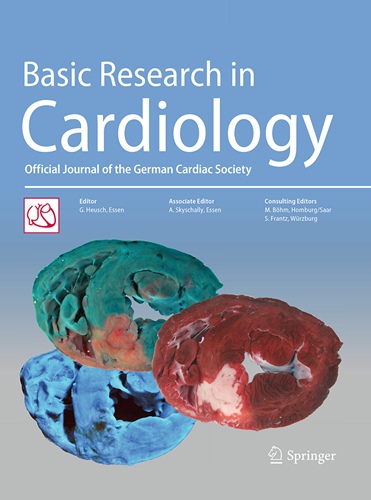Renal denervation attenuates cardiac dysfunction in HFpEF by inhibiting the ATP-P2X7-NLRP3 inflammasome axis.
IF 8
1区 医学
Q1 CARDIAC & CARDIOVASCULAR SYSTEMS
引用次数: 0
Abstract
Heart failure with preserved ejection fraction (HFpEF) arises from intersecting comorbidities involving inflammation, metabolic stress, and sympathetic nervous system (SNS) activation. To mirror this complexity, we established a clinically oriented 3-hit mouse model combining advanced age, a high-fat diet, and chronic NOS inhibition with NG-Nitro-L-arginine methyl ester (L-NAME). We tested whether renal denervation (RDN) mitigates HFpEF by blunting SNS outflow and the ATP-P2X7-NLRP3 inflammasome axis, and in parallel probed the contribution of this pathway using pharmacologic and cellular approaches. 3-hit mice developed preserved ejection fraction with diastolic dysfunction, cardiomyocyte hypertrophy, interstitial fibrosis, impaired exercise capacity, and elevated inflammatory cytokines, accompanied by increased myocardial ATP, activation of P2X7/NLRP3 signaling, oxidative stress, and pyroptosis.RDN lowered systemic and myocardial norepinephrine, suppressed P2X7-NLRP3 inflammasome activation, reduced fibrosis and cardiomyocyte cross-sectional area, improved E/e' and exercise capacity, and reduced oxidative stress and myocardial injury. In pharmacological intervention experiments, selective blockade with the P2X7 antagonist A438079 or the NLRP3 inhibitor MCC950 improved diastolic function and exercise capacity and attenuated myocardial fibrosis and cardiomyocyte hypertrophy. Complementary mechanistic studies in cardiomyocytes (H9c2 and primary neonatal rat cardiomyocytes) showed that ATP induced mitochondrial ROS accumulation, inflammasome activation, cytokine release, and cell injury, which were partially reversed by P2X7 knockdown or pharmacological antagonism. Together, these data validate a multi-hit HFpEF model and implicate an SNS-driven ATP-P2X7-NLRP3 axis as a potential therapeutic target. Both RDN and selective pathway inhibition improved diastolic function and attenuated ventricular remodeling, and inform future therapeutic strategies for HFpEF characterized by heightened sympathetic tone.肾去神经支配通过抑制ATP-P2X7-NLRP3炎症小体轴减轻HFpEF的心功能障碍。
保留射血分数的心力衰竭(HFpEF)是由炎症、代谢应激和交感神经系统(SNS)激活等合并症引起的。为了反映这种复杂性,我们建立了一个临床导向的3-hit小鼠模型,结合高龄、高脂肪饮食和ng -硝基- l -精氨酸甲酯(L-NAME)慢性NOS抑制。我们测试了肾去神经(RDN)是否通过减弱SNS流出和ATP-P2X7-NLRP3炎症小体轴来减轻HFpEF,并同时通过药理学和细胞方法探讨了这一途径的作用。3击小鼠的射血分数保留,伴有舒张功能障碍、心肌细胞肥大、间质纤维化、运动能力受损、炎症细胞因子升高,并伴有心肌ATP增加、P2X7/NLRP3信号激活、氧化应激和焦亡。RDN降低全身和心肌去甲肾上腺素,抑制P2X7-NLRP3炎性体活化,减少纤维化和心肌细胞横截面积,提高E/ E′和运动能力,减轻氧化应激和心肌损伤。在药理学干预实验中,P2X7拮抗剂A438079或NLRP3抑制剂MCC950选择性阻断可改善舒张功能和运动能力,减轻心肌纤维化和心肌细胞肥大。在心肌细胞(H9c2和原代新生大鼠心肌细胞)中进行的补充机制研究表明,ATP诱导线粒体ROS积累、炎性体激活、细胞因子释放和细胞损伤,这些可通过P2X7敲除或药物拮抗部分逆转。总之,这些数据验证了多靶点HFpEF模型,并暗示sns驱动的ATP-P2X7-NLRP3轴是潜在的治疗靶点。RDN和选择性通路抑制均可改善舒张功能和减轻心室重构,并为以交感神经张力升高为特征的HFpEF的未来治疗策略提供信息。
本文章由计算机程序翻译,如有差异,请以英文原文为准。
求助全文
约1分钟内获得全文
求助全文
来源期刊

Basic Research in Cardiology
医学-心血管系统
CiteScore
16.30
自引率
5.30%
发文量
54
审稿时长
6-12 weeks
期刊介绍:
Basic Research in Cardiology is an international journal for cardiovascular research. It provides a forum for original and review articles related to experimental cardiology that meet its stringent scientific standards.
Basic Research in Cardiology regularly receives articles from the fields of
- Molecular and Cellular Biology
- Biochemistry
- Biophysics
- Pharmacology
- Physiology and Pathology
- Clinical Cardiology
 求助内容:
求助内容: 应助结果提醒方式:
应助结果提醒方式:


